Whether starting a freelance business or running a growing agency or B2B brand, generating quality leads is the name of the game.
It’s key to making money online, so it’s no wonder 79% of marketers say it’s their top priority in 2023.
But 61% of them also say it’s their most challenging task.

Is it possible to generate qualified leads without it becoming the bane of your existence?
Fortunately, it is. And in this article, we’ll tell you seven ways to do just that.
Inbound vs outbound
Traditionally, lead gen has been all about cold outreach — identifying prospects and contacting them via cold calling or emailing. It’s a labor-intensive numbers game that requires constant and high-volume activity to keep your sales pipeline full.
However, in recent years, inbound marketing strategies have become increasingly popular. That’s because inbound delivers results more cost-effectively than outbound.
Inbound leads cost 67% less than outbound leads. And if that’s not enough reason to add a strong inbound strategy to your marketing playbook, consider this: a well-integrated inbound strategy can drive up to 1,270% ROI.
With that in mind, we’ve brought you seven inbound marketing strategies you can use right now to turbocharge your revenue. But first, you’ll need to clearly define your target.
Defining your ideal customer
The first step in any marketing strategy is defining your ideal customer. If you don’t nail down who you’re marketing to, your efforts may miss their mark, and you could end up wasting time and resources.
Most marketers use some version of a buyer persona to define who their target customer is. Some use different buyer personas for each audience segment.

For example, you might target young professionals between the ages of 24 and 39 with a college degree who have an average annual income of between $75,000 and $125,000.
Within that target audience, you could segment further into groups such as married vs single, parents with children vs adults without children, and so forth.
Being as specific as possible in your buyer persona and ideal customer segments will help you create the most valuable content for your inbound marketing campaigns and result in the most possible conversions.
Strategy 1: Launch your own podcast
A decade ago, podcasts were a niche pursuit. But in the last five years, their popularity has sky-rocketed, and today, more than half of all US consumers listen to them.

And it’s not an expensive venture, either. For instance, PodBean’s lowest-priced plan starts at just $9 and features unlimited storage space, unmetered bandwidth, distribution to all major podcast apps, and more.
But how can starting a podcast feed into your lead-generation efforts?
Well, there’s growing interest in business-related podcasts. In fact, 75% of podcast listeners tune in to learn something new, and over half of podcast audiences are likely to purchase something after hearing an ad for it during a show. So, there’s a ton of opportunity for those prepared to explore this medium.

By launching a podcast, you can discuss topics related to your audience’s pain points and demonstrate how your service could solve them. For instance, marketing agencies could talk through issues such as:
- Demonstrating ROI from marketing activities
- Creating content that delivers results
- Attracting more of the right sort of traffic
What’s more, podcasts lend themselves well to collaboration. Reach out to people in your network with a similar audience but aren’t direct competitors, then invite them to your podcast. That way, you can tap into their audience and your own, which will help you grow your podcast following.
So far, so good. But where does the lead generation aspect come in? How can you transform podcasting into an activity that contributes to your broader inbound marketing strategy? Well, there are a few tactics that can work well.
Step 1: Create supplementary gated content
The average podcast is between 20 and 40 minutes long. That’s certainly enough time to discuss two or three areas related to your podcast subject. But it’s probably not long enough to cover the topic from all angles.
For instance, your podcast might be all about driving more of the right sort of traffic. On the podcast itself, you might discuss the following:
- How to identify the right audience
- Tactics for reaching that audience
- What kind of content will engage your audience
You could also create gated content — like an infographic, an ebook, or flyer designs — that goes into greater depth on one of these areas or provides insights and actions on something you didn’t have time to discuss on the podcast.

Hiring a graphic designer to make the content more attractive is worthwhile if you have the resources to spare.
Tell your listeners about this gated content and where they can find it (preferably in a prominent position on your website). You’ve turned your podcast listeners and website visitors into leads marketing your podcast without spending hours on it.
Step 2: Ask your audience to get in touch
There are many reasons your listeners might want to contact you. For instance, they might want you to tackle a specific subject. They might have follow-up questions after an episode or even want to appear in one themselves!
Direct all of these communications toward a simple contact form on your website. This is a great way to capture names and contact details and invite them to subscribe to your newsletter.
Step 3: Create transcripts of each episode
Podcasts are fantastic for giving an overview of a topic. But listeners can’t skim podcasts like blog posts or articles. And unless they pay close attention and take notes, they may miss some of the information provided.
These details can make it hard for listeners to put your valuable advice into practice.
But, if you create a transcript of every episode, publish it on your blog, and direct listeners to it, you offer a solution to each problem while offering alternative content for segments of your audience who may not love podcasts.
Transcribing your podcast is simple and doesn’t need to cost much. Check out tools like RSS.com for no-cost options.
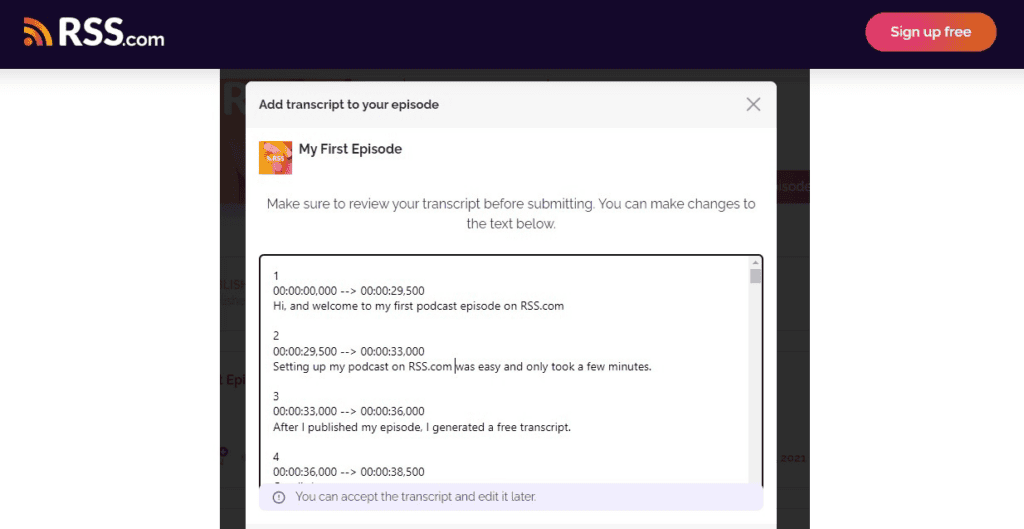
If you need more bells and whistles, look into services like Rev, which offers a choice between AI-powered automated transcription and human transcription, and choose what’s best for you.
Don’t forget to look for opportunities to incorporate internal links to other relevant content and include calls to action (CTAs) to your products and services wherever possible.
Strategy 2: Nurture prospects with email marketing
Inbound marketing strategies aren’t solely about filling your funnel with leads. And it’s crucial to remember that email marketing is both an inbound and outbound marketing strategy.
You use outbound marketing strategies when you reach out to potential customers to generate new leads through cold emails. But, once those leads subscribe to your newsletter, podcast, or promotional marketing, they become part of your inbound marketing.
Inbound marketing doesn’t deliver instant results.
You can’t expect to record one podcast episode or publish one ebook, and instantly generate thousands of dollars in new business.
You need to build an email sequence to help you do this. Email management tools can act as your ace in the hole in designing the perfect nurturing sequence.

Every lead-nurturing email sequence will be different, depending on how you captured that lead in the first place and the next action you want them to take. Here’s an example of how a sequence could look for people who’ve just downloaded your latest ebook:
- Email 1: Thank them for downloading the ebook (and attach it, too, in case they had trouble with the first download)
- Email 2: Follow up with additional value, such as a checklist or cheatsheet that didn’t make it into the ebook
- Email 3: Form a personal bond by introducing yourself and adding personalization — such as a personal origin story or how you pivoted careers
- Email 4: Add further value related to their pain points, such as a free tool or how-to guide
- Email 5: Describe how your product or service solves one of their key pain points and ask if they’d like a demo or consultation
There are many additional steps you could add here, too. For instance, after the fifth email, you might follow up again with a case study or testimonial from an existing customer in your prospect’s industry.
Send each email between one and three days after the previous one. Successful nurturing campaigns typically consist of 5–10 emails.
Strategy 3: Create thought leadership content
Thought leadership content is integral to an effective inbound marketing strategy. It demonstrates your expertise and provides a strong incentive for prospects to hand over their contact details. And most importantly, decision-makers love it, with most reading thought leadership content for at least one hour every week.
With all that in mind, it’s unsurprising that 65.4% of marketers use thought leadership in their content strategies.

While “thought leadership” broadly refers to any content that positions you as an authority in your field, the ebook and white paper are the most common formats from a lead generation perspective.
The difference between the two can be subtle and even arguable. However, most marketers will agree that a white paper is an in-depth, authoritative report on a specific topic that presents a problem and provides a solution. White papers are typically dense, informative, technical, and lengthy (at least six pages, but can be 50 pages or longer).
MarketSplash says, “White papers are the most effective content type (83%) for lead nurturing.” So, including them in your marketing strategy is a wise move.
An ebook, by comparison, can be any length and contains illustrations and images to break up the text and make it more skimmable. Ebooks can cover any topic, including fiction.
While both types of content work for lead generation, you must decide which is appropriate for your target audience and your marketing strategy.
Here’s how to get started creating thought leadership content.
Step 1: Choose a topic
You need your ebook or white paper to resonate with your target audience, so it should ideally speak to one of their key pain points. If you’re not clear on what these are, speak to your sales and client relations teams — after all, they’re the people who spend the most time talking to your existing and prospective customers.
Need a little extra help? Answer the Public, a tool that takes user search data and condenses it into the most common questions (or searches) people ask Google, can help you generate new content ideas, brainstorm titles, and more.
In this example, we can see common “how” searches on SEO (search engine optimization):

Once you choose a topic, it’s time to create your content. As a general guide, for an ebook, you should aim for at least 2,000–3000 words broken down into several chapters, although some are much longer. For a white paper, as mentioned above, no less than six pages and as long as necessary to provide detailed information.
Once you’ve completed the copy, be sure you’ve also included helpful images throughout the text that add value for the reader. Images such as infographics, charts, quotes, and screenshots. For white papers, keep the images professional and minimal.
Finally, convert the file to a pdf for easy upload and download. And if you need help merging your PDF documents, you can use a tool like PDFSimpli.
Pro Tip: When working with a content team, use a tool like Draftable to help compare documents securely throughout the editing process.
Step 2: Build a landing page
You could create the best, most insightful ebook the world has ever seen, but without a high-quality landing page optimized toward conversion, you won’t generate the leads you deserve.
When creating a landing page, your goal is simple: to compel people to complete your data capture form and download your content.
You can take inspiration from other landing pages that perform well in your niche by simply converting them to pdf using a webpage to pdf API for taking notes, and then converting them back into a lead generation machine.
The following best practices will help you:
- Write a compelling title that shows visitors they’ve come to the right place.
- Tease your content by including key takeaways in bullet points (without giving all your best information away for free).
- Add trust factors, such as the names of business leaders you interviewed or how many people you surveyed.
- Craft a strong call to action that speaks to the benefits of downloading.
- Keep your lead capture form simple. The fewer fields you have, the higher your competition rate will be.
Speaking of completion rates – keeping your conversion rates high is how you fill your sales pipeline. It’s also how you gain a better understanding of your ideal customer.
Just like you track your website traffic via Google Analytics, you should track your customers’ behavior using the right tools.
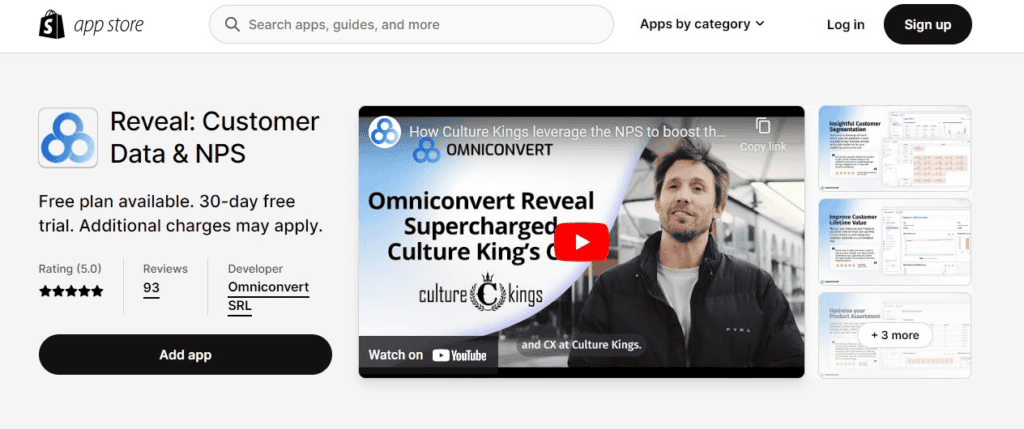
The Omniconvert Reveal tool can help you do just that by tracking customer analytics and segmentation. The tool segments customers based on buying behavior and then uses that data to create personalized buying journeys.
Remember, getting traffic to your landing page isn’t your end goal. Instead, converting that traffic and retaining those customers long-term is key. So, optimize your landing page as you build it and analyze the data you collect.
Step 3: Promote it
It doesn’t matter how great your content and landing pages are if no one knows about them. To generate interest and leads, you need promotion.
There are lots of methods for promoting thought leadership content. What works best for you largely depends on your audience, the platforms they use, and the messaging that resonates with them. However, the following tactics work well for most brands.
- Promoting your content to your existing mailing list
- Advertising in newsletters and on industry sites
- Partner with influencers and thought leaders in your niche to promote your content
- Running ads on Facebook, Google, and Linkedin
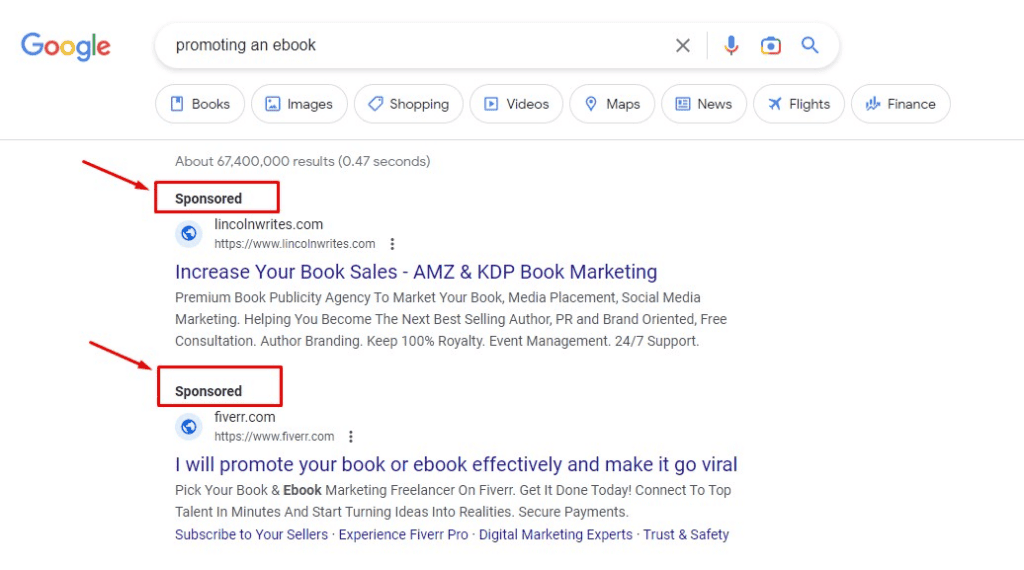
Strategy 4: Write in-depth blog content
Blogs aren’t just about driving organic growth — they’re also integral to effective inbound marketing strategies.
But as any SEO expert will tell you, there’s no point in writing blogs if they don’t bring in traffic. That means keeping SEO best practices in mind. Such as:
- Get the length right: According to SEMRush data, the ideal blog post length depends on several factors and can range from 1000–3000+ words. But don’t just pad out your blogs with unnecessary words. Keep them concise and informative.
- Win backlinks: Provided your content is sufficiently high quality, it should be possible to capture high-quality backlinks. Of SEOs, 40.7% say content marketing provides the strongest passive link-building results. In turn, that’ll help your blog rank better while also generating referral traffic.
- Optimize for image search: Add visual elements to your blog post through the WordPress visual editor, editing the alt-text to incorporate targeted keywords.
- Target the right keywords: Use a tool like Ubersuggest to find relevant keywords you can naturally reference throughout your blog.

Once you choose a keyword, make sure you can rank for it. Ubersuggest can help you with this too.
Simply do a quick search of your target keyword. For example, if you search for the keyword ‘invest in stocks,’ you’ll see metrics like the SEO difficulty score, search volume, and more.
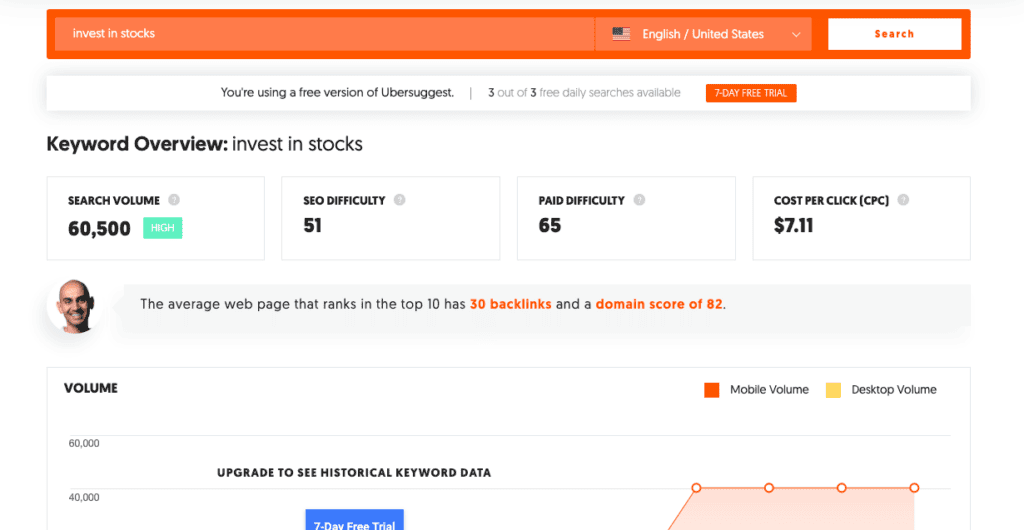
If the difficulty score is low, there’s less competition for that keyword, and you have a better chance of ranking for it if you optimize your content.
Search volume indicates how many people have searched for that keyword in the last 30 days. Even if the search volume is low, pursuing a keyword can still be worthwhile if the difficulty is also low. That’s what we call “low-hanging fruit.”
Strategy 5: Run a webinar
Webinars deserve your attention because they’re particularly popular right now. B2B marketers have increased their use of webinars from 57% to 67% in the last year alone.
Why?
Because they’re an invaluable lead gen tactic. According to Business Wire, 89% of marketers describe webinars as the most effective way to capture quality leads.
If you’ve never run a webinar before, don’t worry. They’re not much different from creating any other piece of in-depth, lead-generation-focused content. You still need to:
- Pick a topic that’s relevant to your audience
- Build a high-quality landing page to capture leads (make sure you conduct a B2B website personalization)
- Promote it to existing prospects via email
- Amplify new prospects via ads
However, there are some webinar-specific points to bear in mind:
- Get the length right: 60 minutes is the most popular length for webinars. This timeframe usually consists of 45 minutes of content and about 15 minutes of Q&A.
- Make it interactive: The big differentiator for live webinars is their interactivity. It makes them a lot more engaging than non-live content. Consider adding interactive elements like live chat and polls. To go the extra mile, use a dynamic QR code generator to direct attendees toward a dedicated landing page containing additional content around the points you’re discussing.
- Do a run-through: Don’t assume it’ll be alright on the night! Practice before the event, asking someone to join as a guest, so you can figure out the technical elements of your podcast platform and choose a suitable backdrop.
Strategy 6: Build actionable landing pages
Every landing page on your site should drive a specific action from your audience, from your homepage to your key category or service pages. Hiring a freelance designer will help you ensure that every page looks perfect and contributes to a great customer experience.
So what does this look like in practice? Essentially, it’s about two things:
- Making it clear to your audience what action you want them to take
- Making it simple for them to do
Let’s take a look at the homepage for Hollander Law Firm to see this in action:
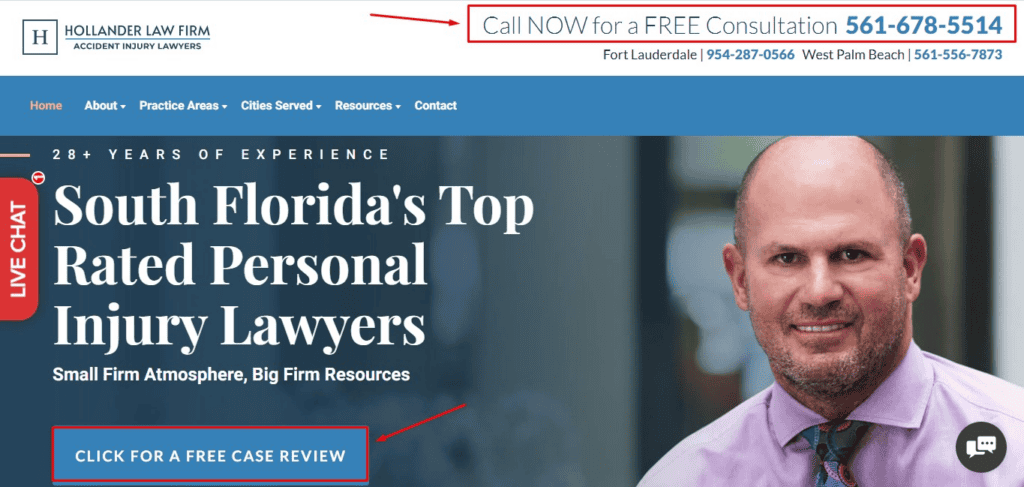
Source: Hollander Law Firm
We see two clear CTAs – one to contact Hollander for a free consultation with their online booking app and another to request a free case review.
Pro Tip: Use a virtual number in the CTA on your landing page to encourage leads to contact you securely.
Strategy 7: Incorporate trust factors
Anyone who’s spent more than a few days in the marketing industry has heard the trio of “know, like, and trust.” These three simple words come together to create a recipe for marketing magic that turns new leads into loyal customers.
If you can get your target audience to know your brand, like your brand, and trust your brand, you’ll have it made in the shade. But how do you get there?
Edelman’s 2023 Trust Barometer Global Report states that “business” is the only ethical and competent entity (with “government” and “media” being the other two considerations). Furthermore, 63% of people buy or advocate for brands based on their beliefs or values.
This same percentage (63%) of US citizens surveyed said that brands could help strengthen the country’s social fabric by “celebrating what brings us together and emphasizing our common interests.”
People want to feel less polarized and more accepted in a post-pandemic world. They want to feel like they belong. If your brand can demonstrate that in its marketing and maintain authenticity throughout your message, you’ll win an audience that’ll stick with you long-term and proudly be your brand ambassador.
Of course, trust factors can vary from one industry to another. For example, prospects in one sector might expect you to use certain words or phrases, while those in another might expect specific accreditations and qualifications.
Attorney Brian White uses client testimonials to demonstrate trustworthiness:

Source: Attorney Brian White
Testimonials and reviews can be a highly effective trust factor. BrightLocal says 98% of consumers read online reviews for local businesses, and “Google is the most trusted review platform across all industries.”
Showcasing testimonials, reviews, and case studies offers social proof that 49% of consumers trust “as much as a recommendation from a friend or family member.” Depending on your industry, your reviews can leverage various information to impress your target market.
For example:
- Marketing agencies can reference how much revenue, or how many customers, they won for a specific client
- Realtors can speak to the value or number of properties they’ve sold in a given period by optimizing their real estate business
- Recruiters can state the average time it takes them to place a new hire or how many candidates they’ve placed
As long as you know your target audience, you can find out what they want to see in social proof. Then all you have to do is deliver it.
Wrapping it up
So what have we learned here?
Well, as you’ve probably noticed, there’s a lot of overlap between different inbound marketing strategies.
You’ll likely need to use a combination of tactics to generate the desired results. For example, you might create thought leadership content, build an actionable landing page, and support your efforts by running a lead nurturing campaign via email.
Ultimately, good inbound marketing rarely exists in silos. The more you add value for your audience and help them solve their business problems, the more leads you’ll generate and deals you’ll close — without making a single cold call!
You’re welcome.



